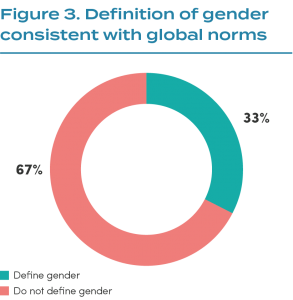Organisational definition of gender: flying blind
Despite a growing commitment to gender equality, for most global organisations active in health, the meaning of gender remains ill-defined or undefined.
Defining gender in a way that is consistent with global standards is a critical early step towards bringing a gender lens to work on global health. Recognising and responding to gender means not only focusing on individual women and men but also on the social, cultural and political systems that determine gender roles and responsibilities, access to and control over resources, and decision-making power.
Just 33% of organisations define gender in a way that is consistent with global norms (see glossary for definition). An additional 11% (21/198) of organisations mention gender-related terms (e.g. “gender diversity”) but do not provide any definition of gender in their work.
Only nine organisations recognise and mention the specific needs of people with non-binary gender identities (including transgender people).
Recommendations
2.1 Global organisations active in health should adopt definitions of gender and gender equality that are consistent with global norms.
2.2 Global organisations should put in place policies and processes to ensure a common organisational understanding and broad ownership of the definition of gender, and the practices required to achieve gender equality.



